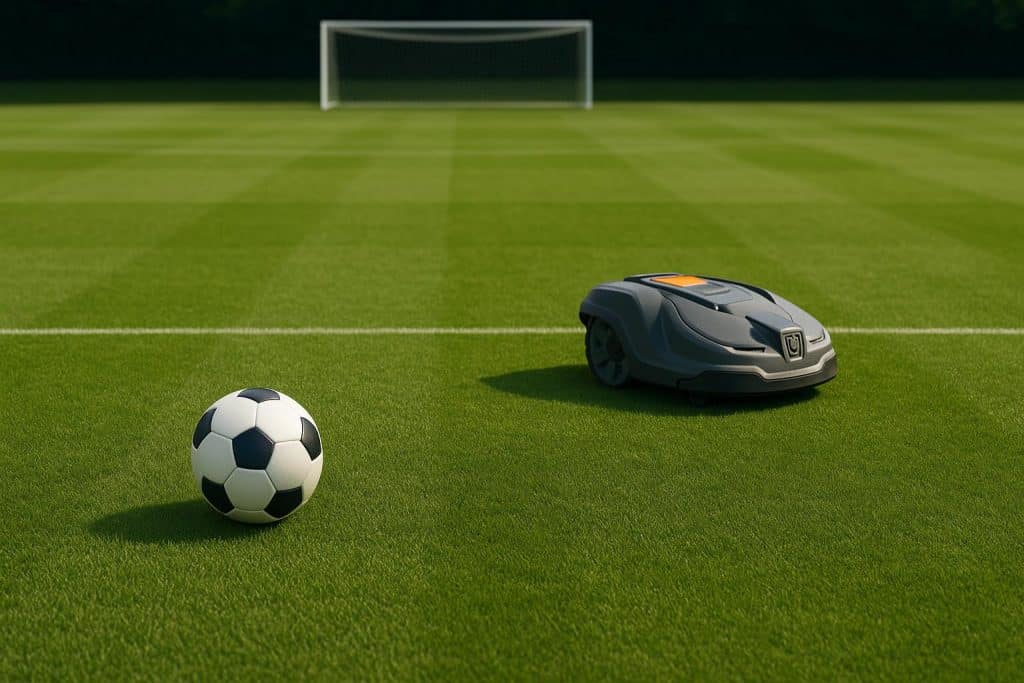In elite football, where marginal gains can determine match outcomes, even the smallest detail on the pitch matters. From the ball’s bounce to player traction, turf quality can influence everything from performance to injury risk. Traditionally, maintaining these surfaces to perfection has required intensive labour, heavy machinery, and a constant watchful eye. But today, thanks to robotic mowing technology, a quiet revolution is reshaping how top-tier football pitches are prepared.
Unlike traditional ride-on or push mowers, robotic mowers operate with surgical precision. They don’t just cut the grass—they manage it. Operating daily and in fine increments, these smart machines follow virtual boundaries set via GPS, gliding effortlessly across turf with consistent cutting height and direction. The result is a carpet-like playing surface, day after day, regardless of weather or usage demands.
One of the most game-changing aspects of robotic mowing is the frequency of the cut. Rather than taking off long blades in one go, these machines operate on a “little and often” principle. Cutting the grass daily promotes dense growth, encourages lateral spreading, and supports a stronger root system—all essential traits for withstanding the wear and tear of regular training sessions and high-intensity matches.
Consistency is king in elite football. Players are trained to expect a certain surface quality that allows the ball to roll true and reduces the risk of slips or unexpected bobbles. With robotic mowers, there’s no variation from one cut to the next. No operator fatigue. No missed patches. Just smooth, even turf that meets professional standards every single time.
This technology also reduces the physical stress placed on the turf. Traditional mowers, especially larger models, compact the soil beneath with each pass. Over time, this compaction can lead to drainage issues and reduced grass health. Robotic mowers are lightweight and non-intrusive. They distribute their weight evenly and move with minimal impact, allowing the soil to breathe and recover naturally.
For clubs focused on sustainability, robotic mowing adds even more value. These machines run on rechargeable batteries, significantly reducing emissions and noise pollution compared to petrol-powered alternatives. Grounds teams can program them to run at night, conserving daylight hours for other maintenance tasks or simply leaving the pitch free for use during the day. It’s not just efficient—it’s environmentally responsible.
Top football clubs have already taken notice. In recent years, several Premier League sides have adopted robotic mowing systems across their training and stadium pitches. One of the UK’s leading turf care experts, Ron Smith, has played a key role in bringing this technology to the forefront, offering state-of-the-art robotic mowing solutions like Husqvarna’s CEORA® and Automower® series to sports venues nationwide. With their support, clubs are rethinking what’s possible when it comes to pitch preparation.
The technology goes beyond simple automation. Fleet management tools allow grounds staff to monitor mower performance, schedule maintenance, and adjust cutting patterns remotely. With EPOS (Exact Positioning Operating System) guidance, there’s no need for physical boundary wires, offering unmatched flexibility when layouts change or turf needs to be rotated. It’s smart turf management, down to the last blade of grass.
For football at the elite level, precision isn’t optional—it’s expected. And robotic mowers deliver that precision not just once, but every day, reliably and autonomously. They don’t just maintain turf—they enhance it. The gains may be quiet, but on match day, when players feel the difference underfoot and the ball moves exactly as intended, the impact is impossible to ignore.
The future of football pitch care is here—and it’s autonomous, efficient, and razor-sharp.
Angela Spearman is a journalist at EzineMark who enjoys writing about the latest trending technology and business news.
